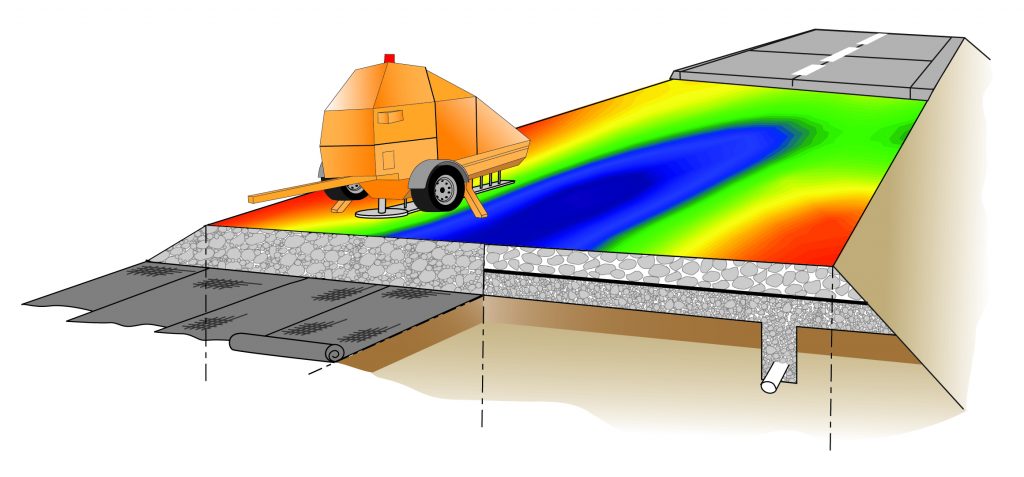InTrans / Oct 31, 2016
Optimizing the support system under concrete pavements

High-quality foundation layers (the natural subgrade, the subbase, and embankment) are essential for optimizing pavement performance. No matter how well a pavement is designed, lack of uniform support conditions can contribute to premature pavement failures.
Unfortunately, many pavements in the United States still fail due to problems with the foundation layers. To help address this situation, a multi-year pooled-fund project (Improving the Foundation Layers for Concrete Pavements, TPF-5[183]) is being conducted by the National Concrete Pavement Technology Center (CP Tech Center) and the Center for Earthworks Engineering Research (CEER). Significant initial funding was also provided by the Federal Highway Administration.
The CP Tech Center and CEER are located at Iowa State University’s Insitute for Transportation.
Scheduled to wrap up at the end of 2016, the project is identifying—and providing guidance for implementing—best practices regarding constructing foundation layers for concrete pavements.
As part of this project, 12 field studies were conducted of several in-service and newly constructed concrete pavements in the participating states: California, Iowa (lead state), Michigan, Pennsylvania, and Wisconsin. These pavements represented a broad range of either successful long-term pavements or pavement sections with premature failures.
For some failures, the existing pavement distresses and underlying foundation were removed and reconstructed, sometimes using innovative technologies. For other pavement failures, the existing foundation and pavement were left in place and rehabilitated. On one distressed pavement in Pennsylvania, for example, the foundation was rehabilitated by injecting expandable polyurethane foam into the base layer.
A key aspect of each field study was to tie performance of the foundation layers to key engineering properties and pavement performance. Foundation layer performance data, as well as original construction data and maintenance/rehabilitation history data, were collected and analyzed.
The goal was to determine the effects of site-specific foundation layer construction methods, site evaluation, materials selection, design, treatments, and maintenance procedures on the performance of the foundation layers and of the related pavements.
The field studies and analyses showed that the quality of pavement foundations varies greatly, depending on agencies’ experience and knowledge.
At all the project sites, the design input parameters for the foundation layers were based on either past experience or very limited field testing. Depending on the test method chosen for verification, however, the design parameters were either higher or lower than the assumed value. Field testing showed that significant non-uniform support conditions exist that are not accounted for in the design. The nonuniform support conditions contribute to increased fatigue in the pavement layers.
These results confirmed the need to move toward identifying best practices for field verifying the project-specific design parameters.
Now, the lessons learned through this project are being compiled into a concise but comprehensive best-practices manual supporting the design, construction, and field verification of economical pavement foundation systems that meet pavement performance requirements. The manual focuses on identifying pavement- and foundation-related pavement distresses, specific failure mechanisms and contributing factors related to the foundation, and key controls and tests.
“By providing state-of-the-art guidelines in one resource,” says David White, who leads the foundations layer project, “this manual has the potential to significantly improve the practice of foundation design and construction and thus reduce the number of foundation-related pavement failures across the country.”
The manual is scheduled to be published by year’s end.
Foundations project progress regularly shared nationally by NC2
Information about progress on the foundations project is regularly shared on a national basis through the National Concrete Consortium (NC2), which is administered and facilitated by the CP Tech Center.
The NC2 provides an organizational structure for twice-a-year meetings of state agencies, industry representatives, and university researchers. The ultimate goal of these meetings is to share information about concrete-related successes and challenges and accelerate the implementation of solutions.
With up to 150 people in attendance, the NC2 meetings allow a unique level of sharing among users, providers, and improvers of concrete-related information and technology. Topics are identified and prioritized for research, publications, and/or training.
The NC2 was instrumental in instigating a multi-year effort “Material and Construction Optimization for the Prevention of Premature Concrete Pavement Distress” (the MCO project). Through projects funded by various stakeholders, detailed information was gathered through site visits in 17 participating states, and research was undertaken to address identified issues. The MCO effort resulted in a variety of resources developed by the CP Tech Center, including a state-of-the-practice manual (a second edition of which will soon be published), a suite of tests, a testing guide, and local and regional workshops.
The NC2 has also been a significant factor in the CP Tech Center’s multi-year focus on concrete overlays. Information collected through research and demonstration projects has been incorporated into a variety of CP Tech Center– published resources: a general guide to concrete overlay solutions (now in its third edition), a design guide, a guide specification, and dozens of related training events.
In addition, through an FHWA pooled fund (the Technology Transfer Concrete Consortium, or TTCC), 30 states that participate in NC2 support research and implementation of priority topics and technologies. The TTCC funds, for example, member states’ participation in CP Tech Center workshops and webinars on a variety of pavement-related topics, including internal curing, concrete pavement recycling, aggregates, surface characteristics, early-age cracking, pavement preservation, roller-compacted concrete, and overlays.
When the foundations project is finished and the manual published in late 2016, final results and training will be shared directly with the NC2—another example of how the CP Tech Center, through its partnerships, helps accelerate implementation and change practice.
From “InTrans En Route – July 2015 to June 2016” published by the Institute for Transportation.